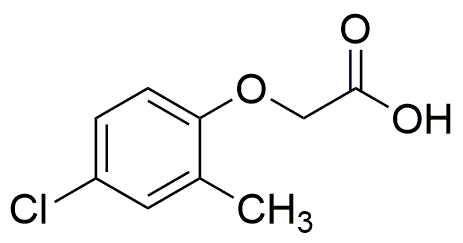(4-Chloro-2-methylphenoxy)acetic acid is widely utilized in research focused on:
- Agriculture: This compound serves as a herbicide, effectively controlling broadleaf weeds in various crops, which helps farmers improve yield and reduce competition for nutrients.
- Plant Growth Regulation: It is used to manipulate plant growth patterns, promoting desirable traits in crops, such as increased fruit size or improved flowering, benefiting horticulturists and agricultural scientists.
- Environmental Research: The chemical is employed in studies assessing the impact of herbicides on ecosystems, aiding researchers in understanding and mitigating environmental effects.
- Pharmaceutical Development: This compound is investigated for potential medicinal properties, contributing to the discovery of new therapeutic agents, particularly in the field of anti-inflammatory drugs.
- Analytical Chemistry: It is used as a standard in analytical methods for detecting and quantifying similar compounds in environmental samples, ensuring accurate assessments of chemical presence in soil and water.
General Information
Properties
Safety and Regulations
Applications
(4-Chloro-2-methylphenoxy)acetic acid is widely utilized in research focused on:
- Agriculture: This compound serves as a herbicide, effectively controlling broadleaf weeds in various crops, which helps farmers improve yield and reduce competition for nutrients.
- Plant Growth Regulation: It is used to manipulate plant growth patterns, promoting desirable traits in crops, such as increased fruit size or improved flowering, benefiting horticulturists and agricultural scientists.
- Environmental Research: The chemical is employed in studies assessing the impact of herbicides on ecosystems, aiding researchers in understanding and mitigating environmental effects.
- Pharmaceutical Development: This compound is investigated for potential medicinal properties, contributing to the discovery of new therapeutic agents, particularly in the field of anti-inflammatory drugs.
- Analytical Chemistry: It is used as a standard in analytical methods for detecting and quantifying similar compounds in environmental samples, ensuring accurate assessments of chemical presence in soil and water.
Documents
Safety Data Sheets (SDS)
The SDS provides comprehensive safety information on handling, storage, and disposal of the product.
Product Specification (PS)
The PS provides a comprehensive breakdown of the product’s properties, including chemical composition, physical state, purity, and storage requirements. It also details acceptable quality ranges and the product's intended applications.
Certificates of Analysis (COA)
Search for Certificates of Analysis (COA) by entering the products Lot Number. Lot and Batch Numbers can be found on a product’s label following the words ‘Lot’ or ‘Batch’.
Numéro de catalogue
Numéro de lot/série
Certificates Of Origin (COO)
This COO confirms the country where the product was manufactured, and also details the materials and components used in it and whether it is derived from natural, synthetic, or other specific sources. This certificate may be required for customs, trade, and regulatory compliance.
Numéro de catalogue
Numéro de lot/série
Safety Data Sheets (SDS)
The SDS provides comprehensive safety information on handling, storage, and disposal of the product.
DownloadProduct Specification (PS)
The PS provides a comprehensive breakdown of the product’s properties, including chemical composition, physical state, purity, and storage requirements. It also details acceptable quality ranges and the product's intended applications.
DownloadCertificates of Analysis (COA)
Search for Certificates of Analysis (COA) by entering the products Lot Number. Lot and Batch Numbers can be found on a product’s label following the words ‘Lot’ or ‘Batch’.
Numéro de catalogue
Numéro de lot/série
Certificates Of Origin (COO)
This COO confirms the country where the product was manufactured, and also details the materials and components used in it and whether it is derived from natural, synthetic, or other specific sources. This certificate may be required for customs, trade, and regulatory compliance.


